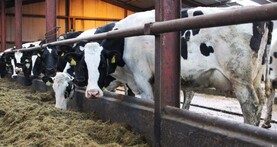Approximately 55% of NI’s 2.5bn litre milk pool is now purchased by three co-ops headquartered in the Republic of Ireland (ROI).
Lakeland Dairies is the biggest processor of NI milk, accounting for 48% or close on 1.2bn litres, which is well ahead of Tirlán which has around 5% of its total 3bn litre milk pool based in NI. Aurivo is the other major Irish co-op purchasing milk from NI farms.
Question
Given the all-island nature of the dairy industry, a recurring question posed by farmers is do these processors pay a similar price either side of the Irish border?
Answering that question is not as simple as just converting a euro base price to sterling. There are major differences between the payment models in ROI and NI, all of which have to be taken into account.
First off, the majority of milk pricing in NI uses a standardised litre with a greater weighting on volume than milk quality. Bonuses on volume, TBC and SCC are also payable in NI, but not ROI.
However, this trend is changing, with all processors offering a range of incentives in NI from 2025 onwards which aim to encourage farmers to increase fat and protein.
In ROI, milk is paid under the A+B-C system, where A is the value of 1kg of protein, B is 1kg of butterfat and C is a deduction for processing costs per litre.
From January 2025 onwards, all farmers in NI supplying Tirlán will be paid under a similar A+B-C model.
Suppliers of Lakeland and Aurivo will be able to opt for an A+B-C model or remain on the current increment system for another year.
Base levels
Another major difference between milk pricing in ROI and NI is the base levels set by processors for butterfat and protein.
In ROI, butterfat is paid from a standardised base of 3.6% across all major processors, while protein is set at 3.3%.
These figures differ from NI, where fat is currently paid from a base of 3.85% to 3.95%, while protein payments are made from base levels ranging from 3.19% to 3.24%.
Where two farmers have identical milk solids, co-ops operating at the lower end of these base level requirements will pay more for fat and protein.
Usually, when a processor has a lower base level for milk solids, they tend to pay from a slightly lower base price to reflect the higher value increments paid out for fat and protein.
To put the differences in milk pricing into context, our analysis compares the 12-month rolling milk prices from November 2023 to October 2024 on both sides of the border for Aurivo, Lakeland and Tirlán.
The average price is calculated for a dairy farmer in line with the average yield and milk solids for each month.
Winter bonuses are factored in as appropriate and the prevailing monthly exchange rate used to convert euro to sterling.
For NI, pricing is based on a farmer producing 750,000 litres annually as per our monthly milk league analysis.
Average milk solids for the 12 months ending October 2024 is 3.32% protein and 4.18% butterfat.
In ROI, pricing is based on a spring calving farmer producing 500,000 litres annually at their rolling average of 3.49% protein and 4.31% butterfat.
Price comparison
Based on the outlined criteria, the 12 month rolling milk price for Lakeland Dairies averaged 38.46p/l in NI, which is just ahead of the ROI average of 38.3p/l.
For Aurivo, the 12-month rolling average price in NI is 38.17p/l and similar to the 38.13p/l paid out in ROI.
In the case of Tirlán, the 12-month rolling average for NI works out at 39.9p/l, under its hybrid A+B-C model, once bonuses on volume, TBC and SCC are included.
That is 0.3p/l ahead of the 39.6p/l paid to the average farmer based in ROI over the last 12 months.
In our calculations there is no allowance for milk supplied on liquid contracts south of the border.
It is also fair to point out that given the typical milk supply curve in ROI for a spring-calving herd, the rolling average price is skewed towards the price that was paid for milk in peak months of spring and early summer.
Since then, prices have been on an upward trajectory, which ultimately is to the benefit of a typical NI producer with a much flatter supply curve.






 This is a subscriber-only article
This is a subscriber-only article










SHARING OPTIONS: